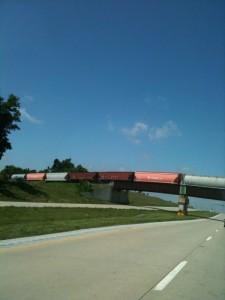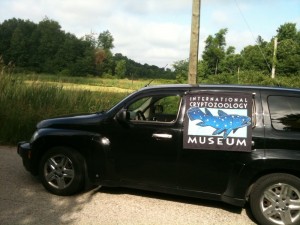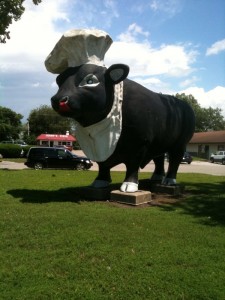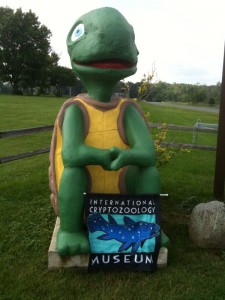
June 23, 2011

Tired of telling your kids to watch and count how many pink train cars they see?
Of course, stopping at a cryptozoology museum is always good. But how about the traveling in-between. In the Northern Hemisphere, it is time to take a r-o-a-d t-r-i-p.
Being a parent (of now grown sons), and in the midst of a current 1400 miles (one way) road trip from Maine to Illinois, I was thinking of some variations on the old “car games” that parents create to keep their kids occupied. Sure, nowadays, most folks fly. But what if you are on a day trip? What if you are driving a few hundred miles, how can you fine tune the skills of your growing “cryptozoologists-in-training” in the back seat?
Obviously, you are not going to see too many Bigfoot or Lake Monsters along the way. But you see lots of cars, so parents often have their kids count special kinds of cars. You know the game. Noting how many VW Beetles or Corvettes each person sees and mentions.
My variation on that is to find a roadside attraction related to cryptozoology. Often I stop to photograph my cryptomobile near it.
Here’s a few examples from this 2011 trip:

My HHR next to Fulk Lake, Indiana, reported habitat of the Beast of Busco.

A giant bull in Logansport, Indiana, a key site in 19th century Giant Snake and the area’s Lake Monster reports. Casually, my HHR is in the background.

Sometimes you even encounter very definite cryptozoologically-inspired roadside art, such as this Beast of Busco. (More on the discoveries about the Beast of Busco tomorrow.)
But more importantly, to the naturalist underneath the young cryptozoologists, I think it is important to train kids to notice, record, and identify roadkill. Roadkill is a visible indicator of the area’s interaction between the mobile animal population and its number one enemy, the automobile.
During this trip, for example, I documented every instance of road kill I saw. And it was a great deal. It included everything from the most common instances being raccoons and groundhogs/woodchucks to the rarest being one example of a squashed snapping turtle.

Location: Townline road, next to Fulk Lake, Indiana; date, June 22, 2011; photo by Loren Coleman.
It might seem commonplace and a minor activity, but until your kids start noticing the roadkill, they won’t be tuned into what’s going on around the car in the natural world. Try it.
There also is a direct logical indication within the increase in roadkill. The wilder an area, the more roadkill there is. And, then, of course, the wilder that section of the travel route, the more possible cryptids might exist nearby for the kids (and you) to see.
(All photos by Loren Coleman, June 2011.)
About Loren Coleman
Loren Coleman is one of the world’s leading cryptozoologists, some say “the” leading living cryptozoologist. Certainly, he is acknowledged as the current living American researcher and writer who has most popularized cryptozoology in the late 20th and early 21st centuries.
Starting his fieldwork and investigations in 1960, after traveling and trekking extensively in pursuit of cryptozoological mysteries, Coleman began writing to share his experiences in 1969. An honorary member of Ivan T. Sanderson’s Society for the Investigation of the Unexplained in the 1970s, Coleman has been bestowed with similar honorary memberships of the North Idaho College Cryptozoology Club in 1983, and in subsequent years, that of the British Columbia Scientific Cryptozoology Club, CryptoSafari International, and other international organizations. He was also a Life Member and Benefactor of the International Society of Cryptozoology (now-defunct).
Loren Coleman’s daily blog, as a member of the Cryptomundo Team, served as an ongoing avenue of communication for the ever-growing body of cryptozoo news from 2005 through 2013. He returned as an infrequent contributor beginning Halloween week of 2015.
Coleman is the founder in 2003, and current director of the International Cryptozoology Museum in Portland, Maine.
Filed under Artifacts, Cryptomundo Exclusive, Cryptotourism, CryptoZoo News, Cryptozoologists, Cryptozoology, Museums, Photos, Pop Culture, Replica Cryptia